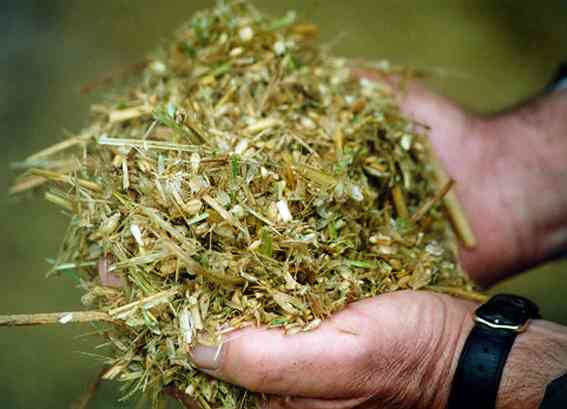Using A Wholecrop Cereal To Top Up Forage Supplies
12 June 2020If you think you may be short of forage for the coming winter cutting and preserving a standing cereal crop to produce wholecrop may be worth considering. It is a good bulk feed and can replace silage if necessary (may need additional protein depending on the stock to be fed) and it is ideal if you have undersown cereals and will give an earlier bite in the field or free up the field for early sowing of a catch crop.
There are two main ways of harvesting a cereal for wholecrop:
Fermented Wholecrop
Around 35-45% dry matter and the ideal time for cutting this is about 4 weeks before normal harvest where the grain can easily be pressed and resemble soft cheddar cheese. Fermented wholecrop can be baled successfully. Starch level in fermented wholecrop is around 20%, this depends on the crop used and the stage of cutting – the earlier it is cut the less starch. Wholecrop is a very versatile feed balanced correctly can be fed to various groups of animals.
Cracked Wholecrop
Around 55-70% dry matter and cereals harvested at the hard dough stage, 2 – 3 weeks before it would normally combined. Direct cutting is required using a forage harvester fitted with a grain cracker to split each grain of cereal. T he grains are fairly mature at this stage and without cracking the grain there would be more wastage when feeding, as more whole grains wouldn’t be digested properly. Cracked wholecrop is not suitable for baling as it is not possible to crack the grains. Cracked wholecrop typically contains 45% grain to 55% straw (when taken at normal cutting height) for both wheat and barley and contains around 30% starch. Therefore, consideration needs to be taken when choosing what animals to feed it to, for example 10kg dry matter of cracked wholecrop would contain 4.5kg dry matter of grain.
Achieving a good fermentation can be tricky with wholecrops, especially when it is taken as a drier, more mature crop and they can be susceptible to heating so it is recommended to use an additive that not only helps fermentation but also helps prevent aerobic spoilage.
Feed Values compared To Grass Silage Of Different Wholecrops
| Crop | Dry Matter (g/kg DM) | ME (MJ/kg DM) | Crude Protein (g/kg DM) |
|---|---|---|---|
| Grass silage average | 240 | 10.6 | 130 |
| Grass silage poor | 220 | 9.9 | 110 |
| Fermented WC barley | 300 | 10 | 95 |
| Fermented WC wheat | 400 | 10.4 | 95 |
| Cracked WC barley | 550 | 10.0 | 85 |
| Cracked WC wheat | 650 | 10.3 | 85 |
Advantages of Wholecrop
- One cut bulk.
- Flexibilty.
- Early harvesting freeing up the field either for grazing if undersown or for putting in an early crop or catch crop.
- Consistent feed.
- Palatable.
Disadvantages of Wholecrop
- Low protein – needs to be balanced.
- Difficult to achieve good fermentation especially if it is dry, additive needed.
- Poor source of minerals – needs balancing.
- Vermin are attracted to it.
- Loss of straw for bedding.
Tips for Baling Wholecrop Cereals
- With the crop mowed on the ground there is potential for soil contamination when baling – ensure cutting height is at least 4 inches.
- Turning down the mower conditioner or using a mower without a conditioner will avoid losses of grains from the head.
- Use at least 6 layers of wrap to ensure no exposure to air; wholecrop, being drier, is more susceptible to yeasts and moulds from aerobic spoilage.
- Chopping the wholecrop will give better compaction in the bale and help with keeping quality but be aware of not chopping too short for the fibre to be effective in the diet. Sheep have higher intakes on chopped forage compared to long forage.
- Using a variable chamber baler is best to produce tighter bales.
- Using a wholecrop additive will help ensure a good fermentation and aid the keeping quality of the bale once it is opened and exposed to air.
- Vermin are very attracted to bales with wholecrop so ensure the area is well baited (can use the empty tubes from wrap to store the bait between bales) and if it is stored outside a net for birds is advisable. Rodents appear to cause more damage in tightly packed stacks, if space allows, store bales on their ends with a gap all the way round will help avoid rodent damage.
Karen Stewart, karen.stewart@sac.co.uk
Sign up to the FAS newsletter
Receive updates on news, events and publications from Scotland’s Farm Advisory Service

